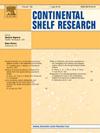Dynamics of small metazooplankton in relation with environmental factors: A 12-year study in the coastal zone of the Southwestern Crimea (the Black Sea)
IF 2.1
3区 地球科学
Q2 OCEANOGRAPHY
引用次数: 0
Abstract
Based on continuous 12-year (2010–2021) monitoring of the average summer abundance of small metazooplankton (SMZ) in the coastal zone of the Southwestern Crimea, the patterns of its interannual fluctuations were investigated. The total SMZ abundance during the study period varied from 37.8 to 176.0 thousand·m−3 in the open coastal area (on average, 104.0 ± 49.2 thousand·m−3) and from 90.3 to 556.8 thousand·m−3 at the bay mouth (on average, 264.5 ± 121.0 thousand·m−3). The crustacean fraction accounted for 85–91% of the total SMZ abundance. Principal component analysis (PCA) showed a noticeable contribution of 48 % of total temperatures and wind speed and different direction repeatability to the SMZ abundance variability. For native data, significant relationships were revealed between the abundance of individual SMZ fractions and hydrometeorological parameters: total temperatures of the warm period of the year (May–October), periodicity of the southern and southwestern, northern winds, calm conditions (events of the absence of wind), and the summer index of the North Atlantic Oscillation (NAO) with a 1-year lag. The application of fast Fourier transform (FFT) with a Hamming filter to the original series and periodograms analysis allowed revealing typical periods of variability in SMZ abundance and hydrometeorological parameters of the environment: 2–4-year and 5–6-year ones. At these scales, a higher number of significant relationships was established with the indicated hydrometeorological parameters, inter alia winter and summer NAO indices, than during the analysis of the original series. The total contribution of hydrometeorological and climatic factors to the variation in the abundance of SMZ increased to 78–79 %. This confirms the assumption that the relationship between SMZ and environmental parameters is characterized by its own features at different scales. Analysis of long-term SMZ different fractions tendencies for Summer 2010–2021, according to the Mann-Kendall criterion, did not show significant results.
小型浮游动物的动态与环境因素的关系:对克里米亚西南部沿海地区(黑海)为期 12 年的研究
根据对克里米亚西南沿海地区小型浮游动物(SMZ)夏季平均丰度的连续 12 年(2010-2021 年)监测,研究了其年际波动规律。在研究期间,沿海开放区的小型浮游动物总丰度从 3.78 万米-3 到 17.6 万米-3 不等(平均为 104.0 ± 49.2 万米-3),海湾口的小型浮游动物总丰度从 9.03 万米-3 到 55.68 万米-3 不等(平均为 264.5 ± 121.0 万米-3)。甲壳类占 SMZ 总丰度的 85-91%。主成分分析(PCA)显示,总温度、风速和不同方向的重复性对 SMZ 丰度变化的贡献率为 48%。就本地数据而言,单个 SMZ 部分的丰度与以下水文气象参数之间存在重要关系:一年中温暖时期(5 月至 10 月)的总气温、南风和西南风、北风的周期性、平静条件(无风事件)以及滞后 1 年的北大西洋涛动(NAO)夏季指数。对原始序列和周期图分析应用带有汉明滤波器的快速傅立叶变换(FFT),可揭示 SMZ 丰度和环境水文气象参数的典型变化期:2-4 年和 5-6 年。在这些尺度上,与原始序列分析相比,与所显示的水文气象参数(特别是冬季和夏季西北环流指数)建立了更多的重要关系。水文气象和气候因素对 SMZ 丰度变化的总贡献率增至 78-79%。这证实了一个假设,即在不同尺度上,SMZ 与环境参数之间的关系有其自身的特点。根据 Mann-Kendall 标准对 2010-2021 年夏季 SMZ 不同分量的长期趋势进行分析,结果并不显著。
本文章由计算机程序翻译,如有差异,请以英文原文为准。
求助全文
约1分钟内获得全文
求助全文
来源期刊

Continental Shelf Research
地学-海洋学
CiteScore
4.30
自引率
4.30%
发文量
136
审稿时长
6.1 months
期刊介绍:
Continental Shelf Research publishes articles dealing with the biological, chemical, geological and physical oceanography of the shallow marine environment, from coastal and estuarine waters out to the shelf break. The continental shelf is a critical environment within the land-ocean continuum, and many processes, functions and problems in the continental shelf are driven by terrestrial inputs transported through the rivers and estuaries to the coastal and continental shelf areas. Manuscripts that deal with these topics must make a clear link to the continental shelf. Examples of research areas include:
Physical sedimentology and geomorphology
Geochemistry of the coastal ocean (inorganic and organic)
Marine environment and anthropogenic effects
Interaction of physical dynamics with natural and manmade shoreline features
Benthic, phytoplankton and zooplankton ecology
Coastal water and sediment quality, and ecosystem health
Benthic-pelagic coupling (physical and biogeochemical)
Interactions between physical dynamics (waves, currents, mixing, etc.) and biogeochemical cycles
Estuarine, coastal and shelf sea modelling and process studies.
 求助内容:
求助内容: 应助结果提醒方式:
应助结果提醒方式:


